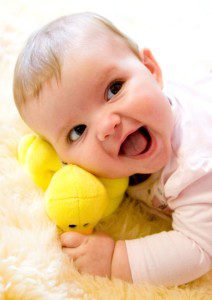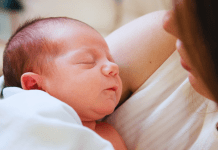This post is sponsored by Baby Sensory Development Classes. We partnered with Baby Sensory to bring Scottsdale Moms Blog readers a unique playgroup experience this past July. For more on infant development classes from Baby Sensory, visit their website.

The Language Path
by Dr. Lin Day
The acquisition of speech and language are complex life skills and yet babies understand words and whole sentences long before they can speak. What is so extraordinary is that babies up to the age of ten months have the capacity to learn several languages. Adults however, have great difficulty in managing the grammar and dialects of new languages because they are accustomed to the sounds and codes of their native tongue.
The drive to communicate is very powerful and babies develop many different ways of expressing themselves before they utter their first words. Body language is one way in which babies communicate before the development of speech. Some studies have shown that teaching babies to sign enhances communication and enables them to develop a better grasp of language in general. Parents feel overwhelmed with joy when babies sign that they are wet, thirsty, hungry, tired or in pain.
Language acquisition increases from simplicity to complexity throughout infancy. The newborn, for example, starts without language. However, by the age of three months, babies can read lips and discriminate between the different sounds of speech. They also develop a delightful repertoire of gurgles, sighs, and coos. By the age of six months, babies may produce repetitive syllables such as ‘da-da-da’. By the end of their first year, some babies have mastered the ability to say a few simple words. Although all babies go through the same stages of language acquisition, each baby learns at a different rate. Some produce their first word at ten months while others talk at 20 months or much later.
The development of the brain pathways, genetic inheritance, maturity of the vocal apparatus, the ability to hear, the quality of care and ample opportunities to interact socially with other people all affect the acquisition of speech and language. Children with weaker verbal abilities are much more likely to experience difficulties learning literacy skills when they enter school than those who have been given high quality opportunities in early life. That’s why it is so important to provide an environment rich in language from the very beginning.
This article provides a very brief outline of the mental and social processes involved in speech and language development from birth to the end of the first year. Activities that can be carried out in the home or day care environment are also suggested.
Bilingual babies
The most interesting and unique feature of language development is that up to the age of ten months, babies have no difficulty in picking up the different speech sounds in the entire range of human languages. They can decode another language based on the rhythms, stresses and intonations of their own language and they can even differentiate between the individual sounds of another language, which adults cannot. It is only after months of repeated exposure to a particular language that babies seem to lose the ability to make distinctions that are not part of their native tongue. Therefore, the earlier babies are exposed to different languages, the easier it is to learn them!
Sign language
Signing is an intriguing and remarkable tool for the development of language. Parents automatically make eye contact, speak slowly and allow the baby time to respond, which promotes excellent interaction. Parents are usually very good at making sense of their baby’s rudimentary hand gestures and actions, which sets the stage for more verbal interactions later on. Signing also allows the parent to communicate more effectively with the baby and the baby experiences less frustration when expressing needs and wants. Hearing babies exposed to spoken and sign language become bilingual in single-word utterance and sign and can switch from one system to the next with ease.
Studies have shown that babies born to deaf parents learn sign language in a similar way to spoken language. Deaf parents may use exaggerated hand and facial movements to convey meaning and in return, babies use a range of hand shapes and movements, gradually narrowing them down to meaningful signs used by their parents. What is so fascinating is that deaf babies born to hearing parents develop their own sign language to express their wants and needs.
Pointing, waving and clapping are special forms of social communication, which enable the baby to convey a specific desire. For example, babies only point when someone is around to pick up an object and hand it to them. They never point when they are alone. Waving and clapping are also social signals which indicate that certain levels of understanding have been achieved.
From crying to talking
Crying
The drive to communicate is very powerful and babies develop many different ways of expressing themselves before they utter their first words. Crying is the first and most effective form of communication. The newborn soon learns that crying will bring food, comfort or companionship. Each baby has a unique cry, which varies in rhythm, intensity and pitch. The type of cry can arouse specific physiological responses in the parent. This may explain why parents often rate cries of hunger and pain as more stressful than those of frustration and boredom. The hunger cry for example, is often very rhythmic, the discomfit cry may be more intense and the boredom cry may stop and start. In return, the parent responds by feeding, cuddling or playing with the baby. In so doing, the baby learns that communication with the parent has been successful.
Parentese
Parents instinctively talk to their babies, and adjust their speech accordingly. The style of speech which involves the use of high-pitched singsong sounds, which exaggerate and elongate the vowels (e.g. ‘babyeee’) is often referred to as baby talk or ‘parentese’. Other features include exaggerated hand or facial gestures and the use of short, simple sentences, which match the baby’s level of comprehension. Studies have shown that the special qualities of parentese can speed up the initial stages of language development. Babies soon learn to distinguish between words with different frequencies and between the different vocalizations of their parents.
Turn-taking
Turn-taking is a fundamental advancement in communication between the baby and the parent and is most noticeable during intimate moments such as feeding, cuddling and nappy changing. For example, the baby coos and the parent responds with enthusiastic vocalizations and body movements. What is so interesting is that the baby actively studies the way in which sounds and mouth movements go together and gradually learns to expect specific words in response to specific situations. This hails the beginning of matching words to specific objects or events such as feeding or cuddling and lays the foundation for future social interaction.
Babbling
By the age of about 6 months, babies experiment with their tongues, teeth, palate and vocal chords to make all sorts of funny noises. However, babbling, the 5 use of elongated sounds such as ‘da-da’ and ‘na-na’, make up the first words that babies use when they start to speak. Babbling requires babies to make lower jaw movements and to bunch up their tongues in the front of their mouths, which they do naturally for feeding. Seventy percent of sounds made by babies all over the world are made using these natural movements, although the sounds are gradually narrowed down to those of their native tongue.
First words
Babies (and humans generally) produce a wide range of sounds important for speech. This is because they have a vocal tract that consists of two linked tubes. These allow for a much larger repertoire of sounds than mammals that have a single tube. However, producing the first recognizable word takes a lot of practice and learning. Babies have to control their breath, mouth shape and the muscles responsible for producing distinguishable sounds. Expanding memory also plays a role in the development of speech. First words are usually contextbound; the result of experience with favourite objects or people that are most familiar. Positive feedback from the parent gives the baby confidence to say them over and over again. By the age of about 12 months, most babies can say one or two words with meaning and can comply with simple requests, e.g. ‘Give me your bottle’ or commands such as ‘Don’t touch!’. They also understand simple questions and can point to a few body parts when asked. Although first words may appear any time after ten months, timing varies considerably between individual babies. Much depends on brain maturity, control of the vocal apparatus and complex social interactions between the baby and the adults around them.
Development of the language pathways
Brain-scanning experiments have shown that both sides of the brain are actively involved in language acquisition, but that from birth, the left hemisphere plays the leading role in the processing of language and speech. The left side also specialises in symbol recognition (e.g. alphabet letters) and the arrangement of letters as words. The right hemisphere deals with word emphasis and intonation, context and meaning. What is clear is that the language pathways develop progressively in the first year of life and that the brain is best able to absorb a language, any language, in the first year of life.
The tongue is also important in controlling articulation, although problems (e.g. the fold beneath the tongue is too tight) are not usually associated with delayed speech. Sound awareness, however, plays an important role in speech and language development. Babies are particularly sensitive to the resonance frequencies of speech, which is why they can distinguish between the different sounds that make up human language. Children who perform well on sound awareness tasks become successful readers and writers, while children who struggle often do not. This is why it is so important to check the baby’s ability to hear and to pay attention to ear infections, especially when they keep occurring.
Ideas for activities
The way in which the adult communicates and interacts with the baby will determine the path that language development takes in the future. Reduced social interaction between the parent and baby may lead to language delays and reading and writing problems when the child goes to school. Parents and practitioners can help babies develop speech and language skills during regular play activities, without adding extra time to the day. There are also plenty of fun things to do during planned play times.
Here are a few ideas:
- Talk to baby during daily routine activities such as feeding, bath time and diaper changing
- Listen to the sounds that babies make and respond with words of encouragement so that they know you are listening
- Use simple speech that is easy for babies to imitate and allow them time to respond
- Use parentese to encourage two-way interaction
- Draw attention to objects and say their names
- Make animal sounds -babies love them!
- Sing lullabies, songs and nursery rhymes to introduce new words and to encourage listening skills and repeat them regularly
- Play turn-taking games involving signs or actions such as ‘Pat-a-cake’ and ‘Peek-a-boo’ and demonstrate pleasure at baby’s response
- Read and reread picture and story books that focus on sounds and rhymes
- Introduce babies to large pictures and take time to name and describe them
- Praise baby for words used correctly


















